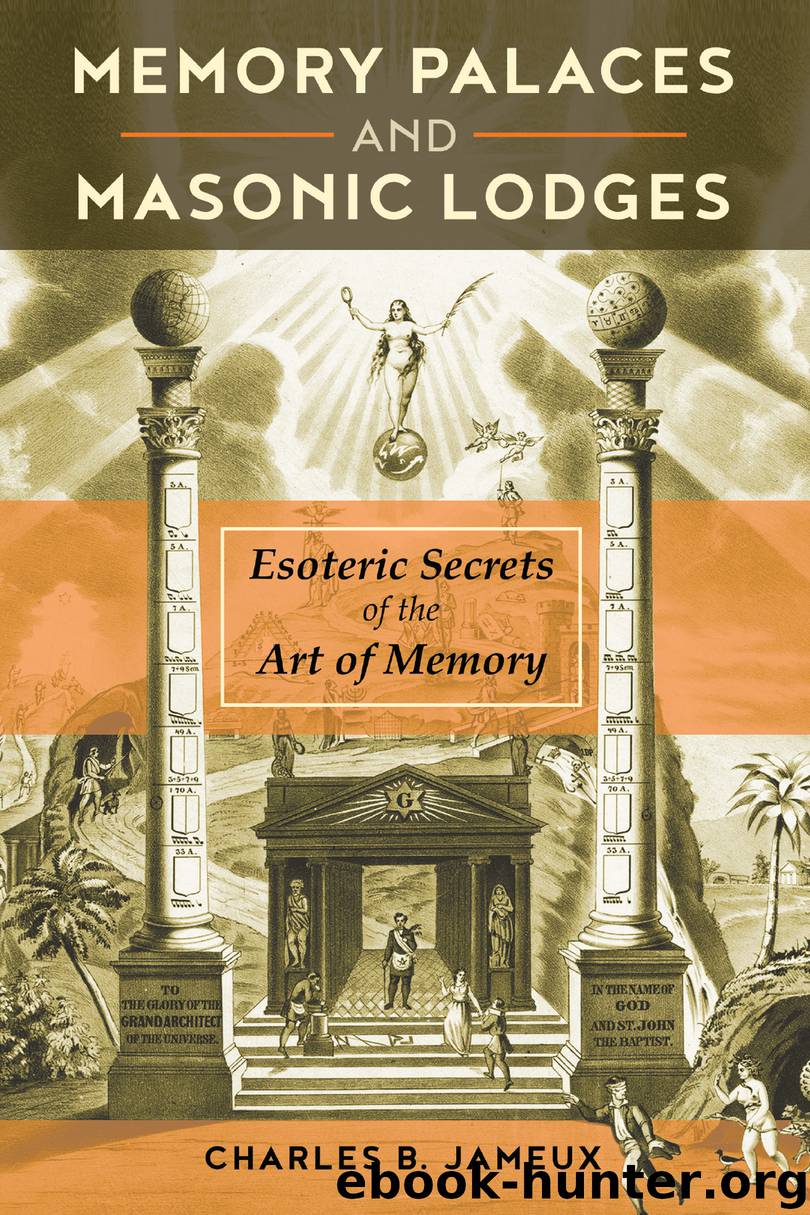Memory Palaces and Masonic Lodges by Charles B. Jameux

Author:Charles B. Jameux
Language: eng
Format: epub, mobi
Tags: Occult/Hermetics
Publisher: Inner Traditions/Bear & Company
Published: 2019-04-26T16:00:00+00:00
APPENDIX B
The Ancient Sources of Initiatic Transmission in Freemasonry
The Royal Art and the Classical Art of Memory
By Charles B. Jameux
The study of the Torah is greater than the rebuilding of the Temple
TALMUD, MEGILLA TREATISE, 166
IT IS OFTEN SAID THAT EVERY Freemason, at least once in his lifetime as an initiate, goes through a phase of self-doubt about his membership in the Masonic Order and his reasons for staying with it. "What am I doing here? What is the point of it all?" he asks himself, wondering whether or not he should continue as a Freemason. This period of self-questioning may be likened to a mood, and it is fairly well known to be short-lived.
_____________
This article originally appeared in the magazine Points de Vue Initiatiques (Initiatory Perspectives), issue no. 100 (special issue devoted to the sources and origins of speculative Freemasonry), in December 1995. It was later published under the title, "Les sources antiques de la transmission initiatique en franc-maçonnerie: art classique de la mémoire," in La franc-maçonnerie—histoire et dictionnaire, ed. Jean-Luc Maxence (Paris: Robert Laffont, 2013) and appears here by permission. Thank you to Noel Castelino for the English translation.
By contrast, I have always felt that for the rest of the time (and this fact is less often noted), Freemasons are not given to asking questions about the origins of their practices and, ultimately, about the deeper meaning of Freemasonry and the experiences that they live within it. They remind me of churchgoers who may know what is going on in the liturgy and have some vague notion of its meaning but no longer possess any idea of why there is a service, why one goes to church, what exactly happens there, and so on.
In other words, I have observed that the members of regular and traditional Freemasonry generally know the "meaning" of the symbols but are not aware of their whys and wherefores. Similarly, they have some broad knowledge of the ritual but cannot explain why rituals exist. They can often define initiation but are incapable of saying how it works. They cannot pinpoint the psychological mechanisms by which a process, generally regarded as being proper to the individual, can be transmitted at a psychological level from one individual to another and, at what might be called the level of the group, from the lodge to the individual.
As to myself, I am of course well aware that I belong to this category of Freemasons. For it must be said that the historical origins of speculative Masonry (the birth of which, as is generally known, took place well before 1717 in the British Isles, and more specifically in Scotland and England) are as yet obscure. Moreover, and although I have been seeking answers to these questions for well-nigh twenty years, I have been unable to find any satisfactory ones, which is perhaps quite understandable, given the complexity and range of the problems involved.
These personal admissions aside, the problems are truly complex and, above all, basic. They involve a great deal more than my own Masonic research.
Download
Memory Palaces and Masonic Lodges by Charles B. Jameux.mobi
This site does not store any files on its server. We only index and link to content provided by other sites. Please contact the content providers to delete copyright contents if any and email us, we'll remove relevant links or contents immediately.
| Ancient & Controversial Knowledge | Ghosts & Hauntings |
| Hermetism & Rosicrucianism | Magic Studies |
| Occultism | Parapsychology |
| Supernatural | UFOs |
| Unexplained Mysteries |
Animal Frequency by Melissa Alvarez(4365)
Sigil Witchery by Laura Tempest Zakroff(4150)
Real Magic by Dean Radin PhD(4049)
Fingerprints of the Gods by Graham Hancock(3899)
Journeys Out of the Body by Robert Monroe(3540)
Aleister Crowley: The Biography by Tobias Churton(3535)
The Rosicrucians by Christopher McIntosh(3442)
Alchemy and Alchemists by C. J. S. Thompson(3422)
Mysteries by Colin Wilson(3363)
Hitler's Monsters by Eric Kurlander(3243)
The Hatha Yoga Pradipika (Translated) by Svatmarama(3184)
John Dee and the Empire of Angels by Jason Louv(3110)
Wicca: a guide for the solitary practitioner by Scott Cunningham(3106)
Infinite Energy Technologies by Finley Eversole(2897)
Book of Life by Deborah Harkness(2836)
Dark Star Rising by Gary Lachman(2803)
The Book of Lies by Aleister Crowley(2780)
Aliens by Jim Al-Khalili(2764)
To Light a Sacred Flame by Silver RavenWolf(2739)
